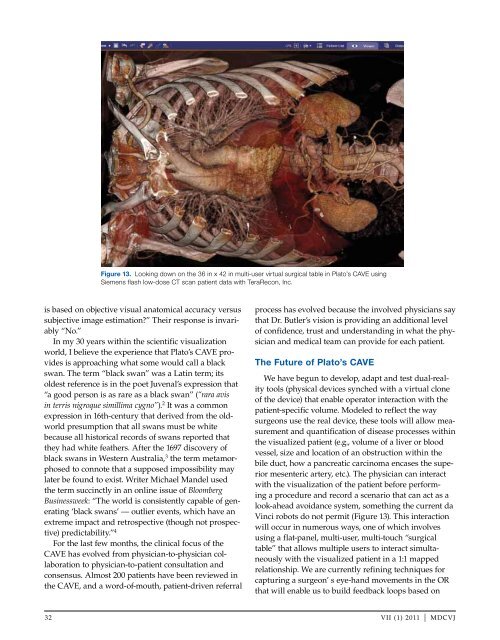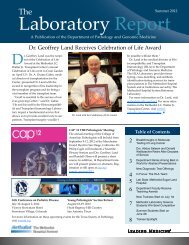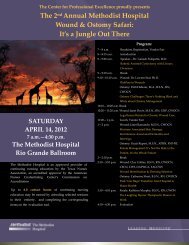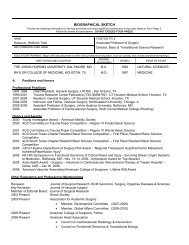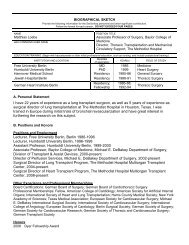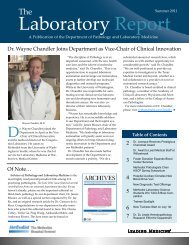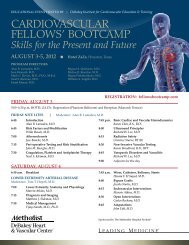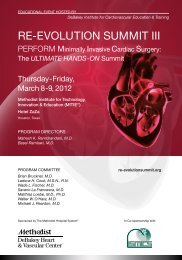DeBAKEy CARDIOvASCuLAR JOuRNAL - Methodist Hospital
DeBAKEy CARDIOvASCuLAR JOuRNAL - Methodist Hospital
DeBAKEy CARDIOvASCuLAR JOuRNAL - Methodist Hospital
You also want an ePaper? Increase the reach of your titles
YUMPU automatically turns print PDFs into web optimized ePapers that Google loves.
Figure 13. Looking down on the 36 in x 42 in multi-user virtual surgical table in Plato’s CAVE using<br />
Siemens flash low-dose CT scan patient data with TeraRecon, Inc.<br />
is based on objective visual anatomical accuracy versus<br />
subjective image estimation?” Their response is invariably<br />
“No.”<br />
In my 30 years within the scientific visualization<br />
world, I believe the experience that Plato’s CAvE provides<br />
is approaching what some would call a black<br />
swan. The term “black swan” was a Latin term; its<br />
oldest reference is in the poet Juvenal’s expression that<br />
“a good person is as rare as a black swan” (“rara avis<br />
in terris nigroque simillima cygno”). 2 It was a common<br />
expression in 16th-century that derived from the oldworld<br />
presumption that all swans must be white<br />
because all historical records of swans reported that<br />
they had white feathers. After the 1697 discovery of<br />
black swans in Western Australia, 3 the term metamorphosed<br />
to connote that a supposed impossibility may<br />
later be found to exist. Writer Michael Mandel used<br />
the term succinctly in an online issue of Bloomberg<br />
Businessweek: “The world is consistently capable of generating<br />
‘black swans’ — outlier events, which have an<br />
extreme impact and retrospective (though not prospective)<br />
predictability.” 4<br />
For the last few months, the clinical focus of the<br />
CAvE has evolved from physician-to-physician collaboration<br />
to physician-to-patient consultation and<br />
consensus. Almost 200 patients have been reviewed in<br />
the CAvE, and a word-of-mouth, patient-driven referral<br />
process has evolved because the involved physicians say<br />
that Dr. Butler’s vision is providing an additional level<br />
of confidence, trust and understanding in what the physician<br />
and medical team can provide for each patient.<br />
The Future of Plato’s CAVE<br />
We have begun to develop, adapt and test dual-reality<br />
tools (physical devices synched with a virtual clone<br />
of the device) that enable operator interaction with the<br />
patient-specific volume. Modeled to reflect the way<br />
surgeons use the real device, these tools will allow measurement<br />
and quantification of disease processes within<br />
the visualized patient (e.g., volume of a liver or blood<br />
vessel, size and location of an obstruction within the<br />
bile duct, how a pancreatic carcinoma encases the superior<br />
mesenteric artery, etc.). The physician can interact<br />
with the visualization of the patient before performing<br />
a procedure and record a scenario that can act as a<br />
look-ahead avoidance system, something the current da<br />
vinci robots do not permit (Figure 13). This interaction<br />
will occur in numerous ways, one of which involves<br />
using a flat-panel, multi-user, multi-touch “surgical<br />
table” that allows multiple users to interact simultaneously<br />
with the visualized patient in a 1:1 mapped<br />
relationship. We are currently refining techniques for<br />
capturing a surgeon’ s eye-hand movements in the OR<br />
that will enable us to build feedback loops based on<br />
32 vII (1) 2011 | MDCvJ


